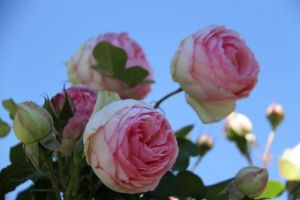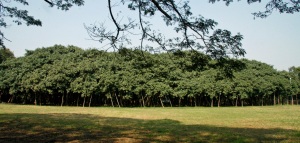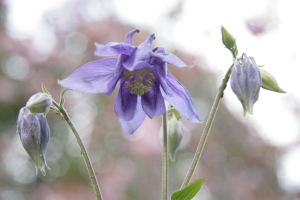Both kids are out for the evening. Interestingly, upon return from the supermarket with multiple bags of shopping now covering the kitchen floor, all sense of domestic obligation has suddenly evaporated. No-one wants to know what’s for dinner… time to blog…

The undisturbed shopping bags seemed quite peaceful...
As it’s a summery Saturday I spent the entire morning at Salamanca market, arms being stretched by bags filled with very sweet and very cheap strawberries and cherries while I indulged in pleasant and drawn out conversations with long-lost friends. One of them was the purveyor of the cherries. I stayed chatting so long that people started asking me for half kilos and I ended up packing bags for her while we caught up. It was Sally Dakis, of ABC radio’s Country Hour, wife of Chris Wisby, also of ABC broadcasting fame – while he’s on air from 6am, she’s out selling the cherries he’s been farming all week. I shared an office with Chris for a while during my Gardening Australia days when I was an itinerant desk-occupier. But that’s another story.
The point is, I shall dine on those fruits while I blog, as no-one else needs dinner. The bags on the kitchen floor look very peaceful. Let us think GARDEN instead.
It’s high time we discussed zucchinis. In languages other than Australian, I believe they are known as courgettes. Same thing.

The plant, the zucchs, the garlic that grew there before them, and some friendly nasturtiums
The important point here is that they are a vegetable with a potentially bad attitude. It’s tempting to compare them with the adolescently undisciplined nasturtiums – lacking regular attention, they get away and do their own thing. But the comparison doesn’t quite stand. Zucchinis have to be watched for a different reason. They look innocent enough, but they have a cunning streak, and if given less than half a chance, very quickly develop an oversized ego akin to that of the alpha male. To avoid this, you must visit your plants daily and eat their babies!
If you don’t, you can be certain that one fruit, most likely hiding under a leaf (bit like Adam?), will start doubling its dimensions daily. This display of dominance is at the expense of the plant’s overall productivity. The alpha-male zucchini demands all the plant’s resources for its exponential, self-centred growth. Its sole motive is reproduction. Left to its own devices, that so-called zucchini will soon become a marrow. The marrow is not what you want. The marrow is full of large seeds, the flesh around them is stringy and mushy at the same time, the flavour is non-existent, the skin is thick and hard, like a shell. That’s right, it has become thick-skinned, domineering and devoid of endearing qualities. Know anyone like that? Would you want them in your garden? I think not.

At the back is the one I found under a leaf - on the way to alpha-maledom
The only culinary solution to the marrow is stuffing ie you scoop out the unwanted stuff and stuff in things that taste good. In my experience, we often don’t get round to stuffing. The thing hangs around the kitchen, or shed, or back verandah, taking up space while you prepare better meals, meals with subtlety.
What we want from our zucchini plants is to eat its babies. Toddlers at the most. A small zucchini is a good zucchini. I reiterate, you must visit your plants daily, preferably in the morning. Why morning? Because they need help with sex, and that’s when it’s possible. Incidentally, this applies to pumpkins as well. If there are no bees and you do nothing about it, there will be no zucchinis and no pumpkins. The window of opportunity is brief, and morning is the time. Let us talk botanically now.
These plants, known as the cucurbits, have separate male and female flowers. The flowers are wide open in the morning and then they close and shrivel. It’s easy to tell the girls from the boys. The girl flowers are held on a stalk that is a baby version of the mature fruit ie a mini-zucchini. The parts inside the flower are complex compared to the male’s flower parts. The male flower is held up high and proud on its long stem, no babies to hold it back. Inside the flower there is just one prong of pollen held up to the sun and the bees. It is that prong of pollen that you must steal. Here’s how…
- Break off the male flower at its stalk;

Male flower on the left, female on the right
- Ruthlessly tear away the petals;
- The pollen stalk is now exposed;
- Rub the pollen stalk onto the female flower parts;
That’s it! You have fertilised the flower and the fruit will set. If the pollen is not transferred by you or a bee, the baby zucchini will soon look sickly, go rotten, and fall off – failure to thrive.
Zucchini management is an important aspect of vegetable growing. If you handle them well, the rewards are many. It’s a simple formula – help with the sex, eat the babies and curb their alpha male urges.

On a sunny morning the bees should do the work for you. Here they are pollinating a female flower.

This bee is headed for the pollen stalk of the male flower.
Practical: Cucurbita pepo; common names: zucchini, courgette, summer squash
General: A summer crop, very easy to grow and bears abundantly. Needs quite a lot of space as it sprawls around continually increasing its spread.
Climate: Zucchinis thrive in dry heat with adequate moisture at their roots. Humidity results in mildewy leaves and shortens the productive life span.
Sun: Full sun is best, less is okay.
Soil: Well drained with good moisture retaining properties and plenty of organic matter and nutrients. Incorporate compost and other organic fertilisers before sowing. Mulch well to keep soil cool and moist.
Water: Regular water is needed for good growth and production. Large leaves soak up lots of sun for fast summer growth but also lose water quickly. In humid climates it’s essential to water the soil not the leaves as mildew will be a problem.
Propagation: In spring sow the large seeds where they will grow or else in small pots. Protect from snails, slugs and rats as they germinate. Given good conditions the plants will quickly establish and grow very fast.
Management: Apart from the obvious needs for water, weeding and mulching, the most important thing is to keep picking the small fruits. Visit your plants daily for two reasons: if there are inadequate bees you need to hand pollinate (see above); regular picking means constant supply. If you allow one to grow into a marrow the flowering will be affected as the plant’s energy goes into producing one big fruit with mature seed for reproduction. That is all it really wants to do, so if that’s going on, the need to keep throwing out new flowers ceases.
Uses: Both flowers and fruit are edible. The flowers are quite delicate and need harvesting in the morning. They only last half a day and then close and wither. Both male and female flowers can be harvested, the males being held on a long stalk while the females are attached to the mini-fruit. The mini-fruit and flower can be picked together. The fruits should be picked after only a couple of days growth as their flavour is superior when young and there are no seeds, just soft white flesh. Their uses are many: slice then grill, fry, barbecue, steam or add to soups, stews, curries, pasta sauce etc. Overgrown fruits are best grated for use in fritters, cakes and breads. Grated is also suitable for salad use.

India sunset
Read Full Post »



















